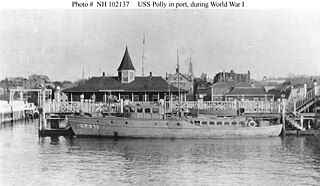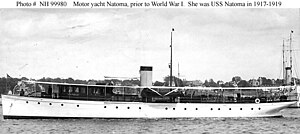
USC&GS A. D. Bache (1901-1927), often referred to only as Bache, continued the name of the Bache of 1871 and has been confused, including in the Dictionary of American Naval Fighting Ships, with that ship even though an entirely new hull and boiler were built in 1901 and only the name and some machinery and instruments were transferred to the new hull. The Bache of 1901 was transferred to the U.S. Navy for World War I service between 24 September 1917 through 21 June 1919 when she was returned to the Coast and Geodetic Survey.

USS Lydonia (SP-700) was United States Navy patrol vessel in commission from 1917 to 1919 that saw service during World War I. Prior to her U.S. Navy service, she had been William A. Lydon's private yacht, Lydonia II, from 1912 to 1917. She spent most of the war based at Gibraltar, escorting and protecting Allied ships in the Mediterranean and along the Atlantic Ocean coast of Europe. After her U.S. Navy service ended, she served from 1919 to 1947 in the United States Coast and Geodetic Survey as the coastal survey ship USCGS Lydonia (CS-302).

USS Wachusetts (SP-548) was an armed motorboat that served in the United States Navy as a patrol vessel from 1917 to 1919. She was renamed SP-548 during her period of service. In 1919 she was transferred to the United States Bureau of Fisheries and renamed USFS Fulmar, and operated as a fisheries science research vessel on the Great Lakes until 1933 or 1934, when she was transferred to the Ohio Division of Conservation.

USC&GS Pioneer was a survey ship that served in the United States Coast and Geodetic Survey from 1922 to 1941. She was the first ship of the Coast and Geodetic Survey to bear the name.
USC&GS Arago was a survey ship that served in the United States Coast Survey from 1854 to 1878 and in the United States Coast and Geodetic Survey from 1878 to 1881. From October 1861 into 1863 Arago was at times attached to the Navy's South Atlantic Blockading Squadron off South Carolina to provide hydrographic support. She was the first ship of the Coast Survey or Coast and Geodetic Survey to bear the name.

USC&GS Matchless was a wood, two masted schooner that served as a survey ship in the United States Coast and Geodetic Survey from 1885 to 1919. She was the only Coast and Geodetic Survey ship to bear the name and the last sailing vessel owned and operated by the Survey.

USC&GS Isis was a survey ship that served in the United States Coast and Geodetic Survey from 1915 to 1917 and from 1919 to 1920.

USC&GS Marinduque was a steamer, owned by the Philippine Insular Government, that served exclusively in the Philippines. The ship was purchased by the Philippine Bureau of Coast Guard and Transportation to support both government logistical and administrative travel needs as well as the usual functions of a coast guard vessel. The vessel was transferred to the United States Coast and Geodetic Survey serving as a survey ship from 1905 to 1932. Marinduque and Romblon were sister ships, both built in Japan.

USC&GS Mikawe was a United States Coast and Geodetic Survey launch in commission from 1920 to 1939.

USC&GSS Research was a survey vessel owned by the Philippine Insular Government to be the first vessel operated by the United States Coast and Geodetic Survey in the Philippines from 1901 until 1918.

The first USC&GSS Pathfinder, also noted in some NOAA histories as "old Pathfinder", was a United States Coast and Geodetic Survey ship in service from 1899 to 1941, when she was beached in sinking condition on January 30, 1942, after 40 years service in the Philippines.

USS Raeo (SP-588) was a United States Navy patrol vessel in commission from 1917 to 1919. Prior to her U.S. Navy service, she operated as the motor passenger vessel Raeo from 1908 to 1917. After the conclusion of her U.S. Navy career, she served as the fishery patrol vessel USFS Kittiwake in the United States Bureau of Fisheries fleet from 1919 to 1940 and as US FWS Kittiwake in the Fish and Wildlife Service fleet from 1940 to 1942 and from 1944 to at least 1945, and perhaps as late as 1948. During World War II, she again served in the U.S. Navy, this time as the yard patrol boat USS YP-199. She was the civilian fishing vessel Raeo from 1948 to 1957, then operated in various roles as Harbor Queen from 1957 to 1997. She became Entiat Princess in 1998 and as of 2009 was still in service.

USS Polly (SP-690) was a United States Navy patrol vessel in commission from 1917 to 1919. After the conclusion of her Navy career, she operated in the fleet of the United States Bureau of Fisheries as USFS Curlew.

USC&GS George S. Blake, in service 1874–1905, is, with the U.S. Fish Commission steamer Albatross, one of only two US oceanographic vessels with her name inscribed in the façade of the Oceanographic Museum, Monaco due to her being "the most innovative oceanographic vessel of the Nineteenth Century" with development of deep ocean exploration through introduction of steel cable for sounding, dredging and deep anchoring and data collection for the "first truly modern bathymetric map of a deep sea area."

USC&GS A. D. Bache (1871–1900), the second steamer of the U.S. Coast and Geodetic Survey, was named for the former superintendent Alexander Dallas Bache and launched August 1871 at Wilmington, Delaware.

USS Onward (SP-311), a former yacht named Galatea and then Ungava was a patrol yacht acquired by the U.S. Navy during World War I. She was transferred to the U.S. Coast and Geodetic Survey where she served briefly until return to the Navy for a brief time before her disposal by sale. She was renamed Thelma Phoebe.

The first USC&GS Explorer was a steamer that served as a survey ship in the US Coast & Geodetic Survey (USCGS) from 1904-1939 with brief time 1918-1919 assigned to Navy for patrol in Alaskan waters. After initial service in the Atlantic the ship transferred to Seattle in 1907 to begin survey work in Alaskan waters during summer and more southern waters in winter. On return from the Navy the ship was condemned and due to be sold. Instead the ship was retained as a survey vessel into the fall of 1939 and existed into World War II when it saw service with the United States Army Corps of Engineers as Atkins.

USS Audwin (SP-451) was a patrol vessel that served in the United States Navy from 1917 to 1919. She then was a survey vessel in the United States Coast and Geodetic Survey from 1919 to 1927.

USS Helianthus (SP-585) was a patrol vessel in commission in the United States Navy from 1917 to 1919, seeing service in World War I. After her U.S. Navy service, she was in commission in the United States Coast and Geodetic Survey as the survey launch USC&GS Helianthus from 1919 to 1939. She was named after the Helianthus, the genus to which the sunflower belongs.

USFC Phalarope was an American fish culture and fisheries science research vessel that operated along the coast of New England. She was part of the fleet of the United States Commission on Fish and Fisheries, generally referred to as the United States Fish Commission, from 1900 to 1903 and in the fleet of its successor, the United States Bureau of Fisheries, as USFS Phalarope from 1903 until 1917 and again from 1919 until fiscal year 1933. She was in commission in the United States Navy as the patrol vessel USS Phalarope from 1917 to 1919, seeing service during World War I. Before her United States Government service, she was the steam yacht Adelita.




















